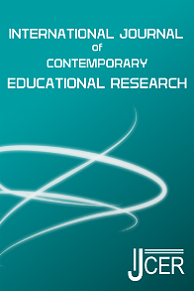Pre-service ELT Teachers’ Prospective Needs and Desires for their Pre-service Teacher Education
DOI:
https://doi.org/10.33200/ijcer.909940Keywords:
Pre-service teachers’ needs and desires, Teacher competencies, Curriculum evaluation, Professional developmentAbstract
The purpose of the study is to explore the voices of pre-service ELT teachers on their prospective needs and desires for their pre-service teacher education curriculum. A qualitative research was conducted with freshman and sophomore students at an ELT Department in a Faculty of Education of a public university in Turkey. To reach an in-depth understanding of participants’ knowledge, qualitative data were collected through 10 focus group discussions which 66 pre-service ELT teachers attended. Inductive analysis revealed that participants’ prospective needs are categorized under two emerging themes: (a) instructional/practical and (b) attitudinal/behavioural development. In addition, the prospective desires of them are categorized under two emerging themes: (a) instructional/practical development and (b) content development. Finally, the participants emphasize reducing the number of theoretical courses from the program and increasing practical courses instead.
References
• Brooman, S., Darwent, S., & Pimor, A. (2014). The student voice in higher education curriculum design: is there value in listening? Innovations in Education and Teaching International, 52(6), 1-12.
• Brownell, M.T., & Pajares, F. (1999). Teacher efficacy and perceived success in mainstreaming students with learning and behavior problems. Teacher Education and Special Education, 22(3), 154-164.
• Caprara, G.V., Barbaranelli, C., Steca, P., & Malone, P.S. (2006). Teachers’ self-efficacy beliefs as determinants of job satisfaction and students’ academic achievement: A study at the school level. Journal of School Psychology, 44, 473-490.
• Cook-Sather, A., & Reisinger, O. (2001).Seeing the students behind the stereotypes: The perspective of three pre-service teachers. The Teacher Educator, 37(3).
• Coskun, A., & Daloglu, A. (2010). Evaluating an English language teacher education program through Peackcock’s Model. Australian Journal of Teacher Education, 35(6), 24-42.
• Council of Higher Education (2020). Retrieved from: https://www.yok.gov.tr/Sayfalar/Haberler/2020/egitim-fak%C3%BCltelerine-yetki-devri.aspx
• Council of Higher Education (2018). New Teacher Education Undergraduate Programs. Retrieved from https://www.yok.gov.tr/Documents/Kurumsal/egitim_ogretim_dairesi/Yeni-Ogretmen-Yetistirme-Lisans-Programlari/Ingilizce_Ogretmenligi_Lisans_Programi.pdf
• Creswell, J.W. (2013). Qualitative inquiry and research design: Choosing among five approaches (3rd ed.). Thousands Oak: SAGE.
• Ell, F., Simpson, A., Mayer, D., Davies, L.M., Clinton, J., & Dawson, G. (2019). Conceptualising the impact of initial teacher education. The Australian Educational Researcher, 46, 177-200.
• Faez, F., & Valeo, A. (2012). TESOL teacher education: Novice teachers’ perceptions of their preparedness and efficacy in the classroom. TESOL Quarterly, 46(3), 450-471.
• Fan, S., & Le, T. (2009). ESL pre-service teachers: What do they need? Paper presented at the Conference AARE 2009, Canberra, Australia. Retrieved from https://www.aare.edu.au/data/publications/2009/fan091517.pdf
• Farrell, T.S.C. (2018). Novice-service language teacher development: Bridging the gap between preservice and in-service education and development. TESOL Quarterly, 46(3), 435-449.
• Fillmore, L.W., & Snow, C.E. (2000). What teachers need to know about language. Center for Applied Linguistics Washington, DC, 1-42.
• Gan, Z. (2013). Learning to teach English language in the practicum: What challenges do non-native ESL student teachers face? Australian Journal of Teacher Education, 38(3), 92-108.
• Gandara, P., Maxwell-Jolly, J., & Driscoll, A. (2005). Listening to teachers of English learners: A survey of California teachers’ challenges, experiences, and professional development needs. The Center for the Future of Teaching & Learning. ED491701
• Gill, P.W., Stewart, K.F., Treasure, E., & Chadwick, B. (2008). Methods of data collection in qualitative research: Interviews and focus groups. British Dental Journal, 204, 291-295.
• Goddard, R.D., Hoy, W.K., & Hoy, A.W. (2000). Collective teacher efficacy: Its meaning, measure, and impact on student achievement. American Educational Research Journal, 37(2), 479-507.
• Groundwater-Smith, S., & Mockler, N. (2016). From data source to co-researchers? Tracing the shift from ‘student voice’ to student-teacher partnership in Educational Action Research. Educational Action Research, 24(2), 159-176.
• Karakas, A. (2012). Evaluation of the English language teacher education program in Turkey. ELT Weekly, 4(15), 1-16.
• Kırkgöz, Y. (2007). English language teaching in Turkey: Policy changes and their implementations. RELC, 38(2), 216-228.
• Kırkgöz, Y. (2005). English language teaching in Turkey: Challenges for the 21st century. In G. Braine (Ed.), Teaching English to the world: History, curriculum, and practice (pp. 159-175). Mahwah: Lawrence Erlbaum Associates.
• Lazar, A.M. (2018). Creating teachers of promise: Growth toward equity-mindedness in a landscape of practice. Teaching and Teacher Education, 71, 308-318.
• Liu, D. (1998). Ethnocentrism in TESOL: Teacher education and the neglected needs of international TESOL students. ELT Journal, 52(1), 3-10.
• Long, H.M. (2005). Second language needs analysis. UK: Cambridge University Press.
• Mann, S. (2005). The language teacher’s development. Language Teaching, 38(3), 103-118.
• Miles, B.M., Huberman, A.M., & Saldana, J. (2014). Qualitative data analysis: A methods sourcebook (3rd ed.). Thousand Oaks: SAGE.
• Ministry of National Education (2017). Overall competences of teaching profession. Retrieved from https://oygm.meb.gov.tr/meb_iys_dosyalar/2017_12/11115355_YYRETMENLYK_MESLEYY_GENEL_YETERLYKLERY.pdf
• The Organization for Economic Cooperation and Development (2009). Creating effective teaching and learning environments: First results from TALIS. Retrieved from http://www.oecd.org/education/school/43023606.pdf
• Seferoğlu, G. (2006). Teacher candidates’ reflections on some components of a pre-service English teacher education programme in Turkey. Journal of Education for Teaching, 32(4), 369-378.
• Sheridan, L. (2011). Exploring pre-service teachers’ perceptions of teacher qualities in secondary education: A mixed-method study (Doctoral thesis). Retrieved from University of Canberra, Australia Database. www.canberra.edu.au/researchrepository/file/6f1047f0-9fec-49db.../full_text.pdf
• Wichadee, S. (2011). Professional development: A path to success for EFL teachers. Contemporary Issues in Education Research, 4(5), 13-21.
• Wu, H.P., & Garza, E. (2016). Pre-service bilingual/ESL teacher identity from a sociocultural perspective. Journal of Teacher Education and Educators, 5(2), 172-191.
Downloads
Published
How to Cite
Issue
Section
License
Copyright (c) 2022 Odiléa ROCHA-ERKAYA, Onur ERGÜNAY

This work is licensed under a Creative Commons Attribution-NonCommercial 4.0 International License.




